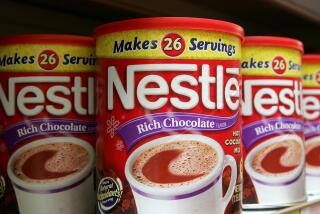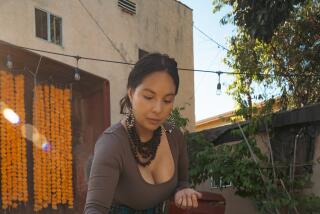Analyzing the Qualities of the Confection
One of the first points Dr. Steven Witherly made to his class of graduate students during a recent lecture was, “It’s cool to drink red wine with chocolate.”
Most students might giggle or even cheer at such academic discourse, but not Witherly’s students. The course he teaches is Sensory Evaluation of Foods; the students work as analytical chemists, quality control managers and new product managers by day and by night work toward their master’s degrees in foods and nutrition from Chapman College. They meet at one end of the library at Carnation Research Laboratories in Van Nuys, where Witherly works as a research scientist.
The topic that night was descriptive analysis, a method of communicating how a food looks, smells, feels and tastes. The test medium: chocolate, and lots of it.
So, instead of being cheered or giggled at, Witherly was questioned. In short, his students wanted to learn more about the organoleptic qualities of combining chocolate and red wine.
“I think the idea is that both chocolate and wine are very complex flavors, but neither overrides the other. They can hold up to each other,” he said.
Witherly promised to address the subject of wine tasting at their final class meeting. But this night he wanted his lecture to be pure chocolate--how it is made and how to understand and evaluate its qualities.
“Good-quality chocolate will have a high cocoa butter content,” he said. “The more cocoa butter the more intense cocoa flavor you get. It is the most expensive ingredient in chocolate except real vanilla, but most manufacturers don’t use real vanilla anymore.
“When high cocoa butter content is backed up by adding an expensive cocoa powder, you get a good strong cocoa aroma and taste with no off-tastes such as burned, musty or earthy that characterize poor-quality chocolate,” he said.
Cocoa butter also lends “snap” to chocolate, Witherly said, meaning the chocolate breaks sharply rather than bending when broken.
“And a good chocolate has a quick meltdown,” he continued. “There’s no fat anywhere that duplicates cocoa butter because it completely melts at body temperature so it doesn’t produce a waxy feel in the mouth.”
There are less-expensive specialty fats used in chocolate making, Witherly said, but none can duplicate real cocoa butter.
“With quick meltdown all the flavors of chocolate are released,” Witherly explained, noting that there are more than 350 chemical compounds that make up the flavor of chocolate.
“Biological systems like quick responses and short bursts of flavor,” he said. “With a high cocoa butter content and quick meltdown you get an unbelievable hedonic burst of flavor in a sudden sucrose solution. It’s the process we commonly describe as ‘melt in your mouth.’ ”
To help his students understand the complexities of chocolate, Witherly had samples of all the ingredients that make up chocolate: chocolate liquors, cocoa butters, one of the specialty fats, dozens of vanillas (real and artificial, including one that was developed specifically for chocolate), powdered milk and cocoa powder. He also had dozens of candy bars on hand.
As his students anxiously eyed what was to come, Witherly went on to explain all the steps in making chocolate and what can go wrong along the way.
Cocoa beans are picked from the cocoa tree, Theobroma cacao, which grows best in the poor soils of West Africa, South and Central America and the Far East. After the beans are harvested, they are allowed to ferment on the ground for up to seven days, which creates the cocoa flavor, then are dried in the sun or by a mechanical drier.
“This is the first place where things can go wrong,” Witherly said. “Rains can cause a fungus to grow, or other extremes of weather can damage the flavor of the beans.”
Next, Witherly said, the beans are sorted and washed by tumbling in water. Then they are roasted to help improve the chocolate flavor.
“Over roasting results in black cocoa,” he said, “and this is what you get in those popular chocolate cookies with the cream filling most of us liked to eat when we were kids.”
The roasted beans are then crushed by rollers, and the shells (which make up 12% of the bean) are separated out, leaving the nib, which is ground to a paste.
From the paste, chocolate manufacturers get three key ingredients: cocoa fat (a white fat with all the flavor components of cocoa), cocoa powder (which contains some fat) and chocolate liquor (the remaining cocoa powder and cocoa butter mixture). The chocolate manufacturers may have imported beans before or after roasting or crushing.
These ingredients are then put back together in proportions according to the specifications of the manufacturer.
Chocolate manufacturers can make a variety of products from chocolate liquor, cocoa powder and cocoa butter. These include sweet chocolate, milk chocolate, bitter or bittersweet chocolate and compound coatings. (The latter, however, often contain vegetable oils such as soy or cottonseed instead of cocoa butter and are used in products such as less-expensive candy bars).
Witherly gave the students a formula for milk chocolate: 40% sugar (to offset the fat and bitter tastes), at least 10% chocolate liquor, 5% to 12% whole milk powder, 1% to 2% butter fat (to soften), 0.2% to 0.5% vanilla, lecithin (the emulsifier that makes the sugar, milk powder and other ingredients stay together) and, of course, all the cocoa butter a manufacturer wants or can afford to put in.
‘More Fat the Better’
“Some manufacturers put as much as 20% cocoa butter in their formulas,” Witherly said, “depending on how much meltdown and snap they want. It’s like making a high-quality ice cream: the more fat the better.”
This mixture of ingredients is refined between huge stainless steel rollers to grind down the particle size. “The tongue is so sensitive it can detect particles as small as 25 to 50 microns,” Witherly said.
Next, the mixture is transferred to huge tubs in a 100-degree-plus room. Here it is conched: Massive marble or stainless steel columns whip around in the tubs, aerating the chocolate, developing flavor and refining texture even more.
The final step is tempering, a process of cooling the liquid chocolate by various methods of heat exchange. “If this isn’t done very slowly, the final product will have streaks of fat in it,” Witherly said.
Most chocolate manufacturers employ professional tasters to analyze each batch of chocolate, usually just before tempering begins.
This might be just one person who, according to Witherly, in 10 to 15 years of working there has memorized the fingerprint of that particular chocolate, its precise look, aroma, texture and flavor.
Talented Tasters
“This is a highly paid individual who has the ability not only to taste chocolate, but to fix it if it is wrong,” Witherly said. “It’s an elite club.”
But, Witherly said, tasters sometimes can’t articulate what they are perceiving to others who may need to know. A better method, he thinks, is to employ a panel of at least five trained tasters who can verify with each other what the qualities of the chocolate are by using agreed upon descriptors, or descriptive analysis.
“I don’t know any chocolate companies in the United States who do this except one,” he said, “but that one works like an analytical machine.”
Witherly gave the class examples of descriptors they could use to analyze chocolate: brown shade, vanillan, brittle, hard, waxy, smooth, sweet, bitter.
He divided the class into two panels, and each gathered around a table to look at, sniff, feel and taste the basic ingredients of chocolate. Next they repeated the four processes with samples of eight different candy bars.
“Humans perceive food first by sight, then smell, texture and taste. That’s why we evaluate in that order,” Witherly explained. “Our senses don’t fatigue as much this way. When food is placed in the mouth it takes five to seven seconds to perceive the taste. In the meantime, we’re already thinking about how the texture feels.”
Eight Descriptors
When the panelists had tasted the sample ingredients and products they decided on eight descriptors: one for color, three for aroma and two each for texture and taste.
Then came the test. The panelists were given two blocks of chocolates to compare, one of high quality, the other a poorer-quality compound coating. They evaluated and scored these using their agreed upon descriptors, their new knowledge from the lecture and their experience from their analyses of the separate ingredients and samples.
Witherly moved back and forth between panels, plucking samples of a favorite candy bar now and then, as his students eyed, sniffed, chewed and seemed to savor the samples.
In the end, both panels reported similar results, and their teacher seemed pleased.
“The students were essentially just trying to find out what makes a good chocolate and to see how different chocolates compare,” Witherly said. “We were just trying to demystify chocolate and break it down into its component parts. But they performed much like experienced professionals. Now they can go out and know how to break down any food substance they happen to be working with into its four component parts.”
One student, Susan Khoshnood, who happens to work with meat, said she can use the same methods in her work as a quality assurance director.
Asked if she enjoyed eating all that chocolate, she said: “I didn’t eat too much. I just tasted it carefully in order to analyze its complexities, so it wasn’t too bad.”
More to Read
Eat your way across L.A.
Get our weekly Tasting Notes newsletter for reviews, news and more.
You may occasionally receive promotional content from the Los Angeles Times.










